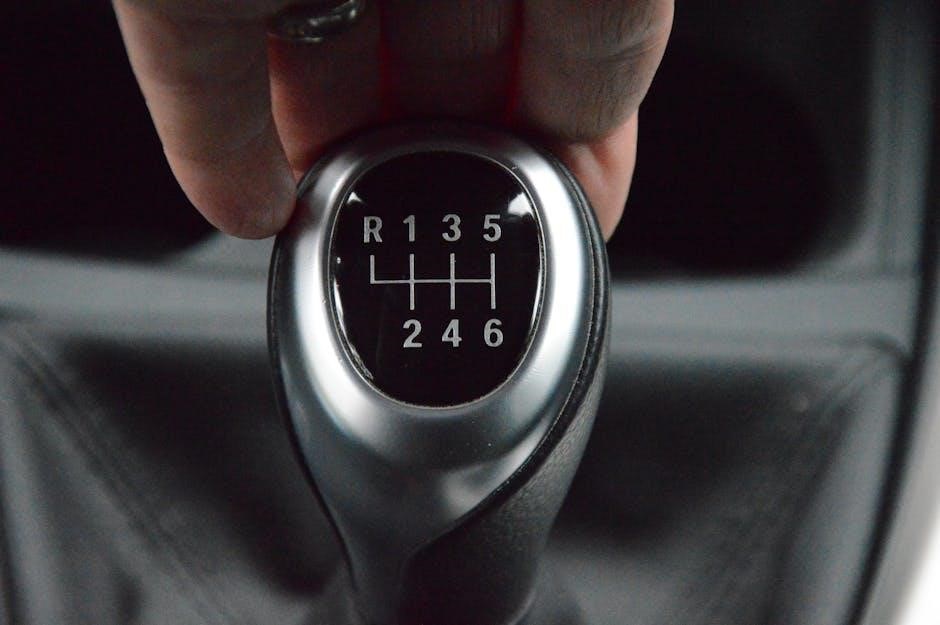Manual transmissions can develop issues over time, often signaled by unusual noises, difficulty shifting, or clutch problems. Early detection is crucial to prevent major repairs.
1.1 Common Causes of Manual Transmission Failure
Manual transmission failure often stems from wear and tear, high mileage, or insufficient maintenance. Components like gears, bearings, and the clutch can degrade over time. Lack of transmission fluid or improper lubrication exacerbates wear. Driving habits, such as aggressive shifting or riding the clutch, can also damage internal parts. Additionally, external factors like road conditions or towing heavy loads may contribute to premature failure. Addressing these issues early is key to extending transmission life.
1.2 Importance of Early Detection
Early detection of manual transmission issues is vital to prevent minor problems from escalating into costly repairs. Ignoring symptoms like grinding noises or difficulty shifting can lead to irreversible damage. Regular inspections and prompt attention to warning signs ensure smoother operation and extend the transmission’s lifespan. Addressing issues early avoids unexpected breakdowns, enhancing safety and maintaining vehicle performance. Swift action can save time and money, preventing the need for extensive overhauls or replacements.

Grinding or Clunking Noises
Grinding or clunking noises during gear shifts are key indicators of manual transmission problems. These sounds often occur when engaging or disengaging gears, signaling potential issues.
2.1 Noises During Gear Shifting
Noises during gear shifting, such as grinding or clunking, are common signs of manual transmission issues. These sounds often indicate worn synchronizers, damaged gear teeth, or faulty bearings. If left unaddressed, they can lead to more severe problems like gear failure or complete transmission breakdown. It’s essential to inspect the transmission promptly to identify the root cause and prevent further damage.
2.2 Clunking Sounds When Engaging Gears
Clunking sounds when engaging gears can indicate worn or damaged components within the transmission. This may include issues with the input shaft bearing, gear teeth, or synchronizers. Such noises are often more pronounced when shifting into first or reverse gears. Ignoring these sounds can lead to further damage, emphasizing the need for a professional inspection to diagnose and address the underlying cause promptly.

Difficulty Shifting Gears
Difficulty shifting gears can manifest as hard shifting, sticky gears, or resistance when moving between gears. This may result from worn synchronizers, damaged gear teeth, or insufficient lubrication, often worsening over time. Professional inspection is recommended to identify and address the root cause before further damage occurs.
3.1 Hard Shifting or Sticky Gears
Hard shifting or sticky gears are common issues in manual transmissions. These problems often stem from worn-out synchronizers, which are crucial for smooth gear transitions. When synchronizers degrade, gears may resist engagement, leading to a stiff or unresponsive shifter. Additionally, low transmission fluid levels or contamination can cause gears to stick, making shifting difficult and unpredictable. If left unaddressed, this can escalate to complete gear failure, requiring costly repairs. Regular maintenance is essential to prevent such issues.
3.2 Failure to Engage Gears Properly
Failure to engage gears properly is a concerning sign of a manual transmission issue. This can occur due to worn clutch components or damaged gear teeth, preventing gears from meshing correctly. If gears consistently slip or refuse to engage, it may indicate a faulty shift fork or synchronizer ring. Ignoring this symptom can lead to further damage, such as stripped gears or transmission failure, necessitating expensive repairs. Addressing the problem promptly is critical to maintaining transmission health and performance.

Clutch-Related Problems
Clutch issues often manifest as slipping or a spongy pedal, affecting gear engagement. Ignoring these symptoms can lead to further transmission damage and costly repairs.
4.1 Slipping Clutch Symptoms
A slipping clutch is often noticeable when the engine RPM increases without a corresponding increase in speed. This can occur during acceleration or when climbing hills. Drivers may feel a lack of control or hesitation in power delivery. Over time, the clutch may wear down faster, leading to more pronounced slippage. If left unaddressed, it can result in the clutch failing entirely, making it difficult to shift gears or maintain momentum while driving.
4.2 Mushy or Spongy Clutch Pedal
A mushy or spongy clutch pedal is a common symptom of manual transmission issues. It occurs when the pedal lacks firm resistance, feeling soft or squishy underfoot. This can result from air in the hydraulic system, low fluid levels, or worn clutch components. Drivers may struggle to engage gears smoothly, leading to inconsistent or incomplete shifts. Addressing this issue promptly is crucial to avoid further damage to the clutch or transmission system over time.

Unusual Smells
A burning odor during operation is a key sign of manual transmission issues. It often indicates overheating components, such as the clutch or gears, requiring immediate attention.
5.1 Burning Odor During Operation
A burning odor during operation is a significant sign of manual transmission issues. It often results from overheating components, such as the clutch or gears, due to excessive friction or insufficient lubrication. This smell can also indicate worn-out parts or damaged bearings. If left unaddressed, it may lead to further damage and costly repairs. Immediate inspection is crucial to identify the source and prevent escalation of the problem.
Leaks or Fluid Issues
Transmission fluid leaks or low fluid levels can lead to slipping gears, overheating, and mechanical damage. Regular inspection is essential to prevent severe transmission failure and costly repairs.
6.1 Transmission Fluid Leaks
Transmission fluid leaks are a common issue in manual transmissions. These leaks can occur due to worn-out seals, damaged gaskets, or loose connections. If left unaddressed, they can lead to low fluid levels, causing gears to overheat and slip. Regularly inspecting the transmission pan and lines for signs of leakage is crucial. A professional mechanic should be consulted to repair any leaks promptly to prevent further damage and ensure smooth gear operation.

Gear Slippage
Gear slippage is a concerning issue in manual transmissions, often causing hesitation, shuddering, or a lack of control during acceleration. It can lead to sudden stalls or inconsistent power delivery, making driving unpredictable. If left unaddressed, it may result in costly repairs. Consulting a professional mechanic is essential to diagnose and fix the underlying cause, ensuring road safety and maintaining vehicle performance.
7.1 Unexpected Slipping Between Gears
Unexpected slipping between gears is a common symptom of a failing manual transmission. This issue often manifests as a sudden loss of connection while accelerating, causing the engine to rev without increasing speed. Such slippage can occur due to worn-out synchronizers, damaged gear teeth, or low transmission fluid levels. If ignored, it may lead to further damage, necessitating costly repairs. Regular maintenance and prompt inspection are vital to address this problem early.

Bushing and Bearing Problems
Worn-out bushings and bearings in a manual transmission often cause unusual noises like thumping, whirring, or clunking sounds during operation, indicating potential internal damage.
8.1 Thumping or Whirring Sounds
Thumping or whirring noises from the transmission often indicate worn bearings or damaged bushings. These sounds may intensify during acceleration or gear changes, signaling internal wear. If left unaddressed, such issues can lead to costly repairs, including bearing replacement or transmission overhaul.
Recognizing signs of a failing manual transmission, such as noises, shifting issues, or clutch problems, is vital for preventing costly repairs; Early detection ensures safety and extends transmission life.
9.1 Summary of Key Symptoms
Key symptoms of a bad manual transmission include grinding or clunking noises during shifting, difficulty engaging gears, a slipping or spongy clutch pedal, burning odors, and fluid leaks. Unusual sounds like whirring or thumping may indicate worn bushings or bearings. Gears slipping unexpectedly or failing to shift smoothly are also common signs. These issues often escalate if ignored, leading to costly repairs. Recognizing these symptoms early can help prevent further damage and ensure vehicle safety.
9.2 Importance of Professional Inspection
A professional inspection is crucial for identifying and addressing manual transmission issues early. Experts can detect hidden problems, such as internal damage or fluid condition, before they escalate. Regular check-ups help prevent unexpected breakdowns and ensure safety on the road. Ignoring symptoms can lead to costly repairs, making timely professional evaluation essential for maintaining your vehicle’s performance and longevity.
